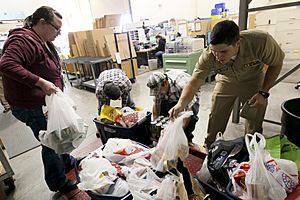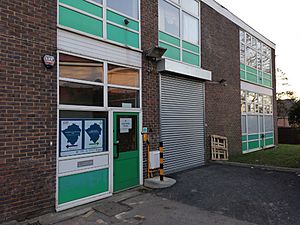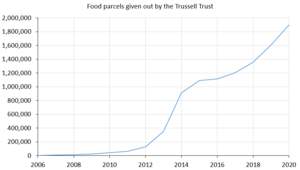Food bank facts for kids

A food bank is a special kind of non-profit group. It helps people who find it hard to buy enough food to avoid being hungry. Food banks usually give food to other groups like food pantries and soup kitchens. These groups then give the food directly to people in need. Some food banks also have their own food pantries and give out food themselves.
The very first food bank was St. Mary's Food Bank in the US. It started in 1967. Since then, thousands of food banks have opened all over the world. In Europe, many more food banks appeared after food prices went up in 2006. They grew even more after the financial crisis of 2007–2008 made life harder for people with low incomes.
Many people like the idea of food banks. They see them as a sign of people helping each other. But some experts worry that having more food banks might make governments less likely to help people in need. Studies have also shown that sometimes food banks are not as efficient as government programs that help people.
Contents
How Food Banks Work

There are thousands of food banks around the world, and they work in different ways.
One main difference is how they give out food. Some food banks work directly with hungry people. They are called "front line" food banks. Others work like a "warehouse". They collect food and then give it to smaller groups like food pantries or soup kitchens. In places like the US and Australia, food banks usually act as warehouses. But in other countries, food banks often give food directly to people.
Another difference is who runs them. Some food banks are run by charities. They often focus on saving food that would otherwise be thrown away. They also encourage people to volunteer. Other food banks are run by labor unions. These often focus more on feeding people in any way they can. They also try to create jobs for people and teach users about their rights.
In the US, a city often has one main food bank. This food bank is like a big warehouse. It collects food and then sends it to hundreds of smaller groups. It works a lot like a business that distributes food. But instead of selling food to stores, it gives food to charities. Sometimes, charities pay a small fee to help cover storage and delivery costs.
Most of the food for US food banks comes from companies. This food might be extra or have slightly damaged packaging. It can come from farmers who grew too much food. It can also come from factories that made too many products. Or it can come from stores that ordered too much. Often, the food is close to its "sell by" date. Food banks work with food companies and safety experts. They make sure the food is safe to eat before giving it out.
People also donate food, often through "food drives." Governments sometimes buy extra farm products and give them to food banks. This helps farmers and also feeds people. Food banks can also buy food at lower prices from stores. Sometimes, farmers let food banks send people to collect leftover crops after the main harvest. This is called gleaning. A few food banks have even tried to grow their own food.
Many food banks used to only accept canned or packaged food. They worried about fresh food going bad. But now, more food banks are accepting fresh fruits and vegetables. This is because people realize how important healthy food is. For example, in 2012, the London Food Bank in Canada started taking fresh food. They saw that it made people feel better, not just healthier.
Summertime can be hard for food banks. This is especially true where children usually get free meals at school. When school is out, more families need help. At the same time, fewer people donate food because they are on holiday.
Food Banks in North America
Early History of Food Banks
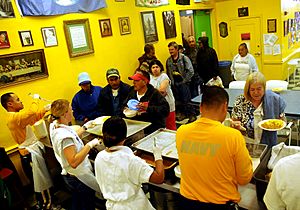
The world's first food bank, St. Mary's Food Bank, started in Phoenix, Arizona, in 1967. It was founded by John van Hengel. Before this, many people in the US thought hunger was no longer a problem.
In the mid-1960s, some states stopped giving out free government food. Instead, they offered early versions of food stamps. These stamps let people choose their own food. But some people couldn't afford the stamps, which led to serious hunger.
People started to help by supporting soup kitchens and other groups. In 1965, John van Hengel learned that grocery stores threw away good food. This food often had damaged packaging or was near its expiration date. He started collecting this food. Soon, he had too much for one dining room. So, he created a central place for all charities to get donations. This became the first food bank.
Food banks quickly spread across the United States and into Canada. By 1976, van Hengel started the group now known as Feeding America. Today, their network has over 200 food banks. They help 90,000 projects. Other large groups exist, like AmpleHarvest.org. This group helps connect home gardeners with food pantries.

In the 1980s, US food banks grew very fast. Before then, people had pushed politicians to improve government welfare programs. In the 1970s, government spending on hunger relief grew a lot. Food stamps were given free to those most in need. Many felt government help was better than charity. Charity could be unreliable and might make people feel ashamed.
But in the early 1980s, the government reduced welfare programs. This led to a quick rise in local hunger relief groups. Most US food banks started after 1981. At first, some people argued that government help was still better. But over time, food banks became a normal part of how America deals with hunger.
Demand for food banks grew even more in the late 1990s. This was after changes to welfare laws. In Canada, food banks also grew quickly after welfare cuts in the mid-1990s. By the 1980s, food banks had started to spread from the US to other parts of the world. The first European food bank opened in France in 1984. In the 1990s and early 2000s, food banks started in South America, Africa, and Asia. Often, John van Hengel helped them get started. In 2007, The Global FoodBanking Network was created.
Pet Food Aid
Some US cities have groups that give dog and cat food to pet owners who need help. For example, Daffy's Pet Soup Kitchen in Lawrenceville, Georgia, is a large pet food aid group. It started in 1997 when Tom Wargo saw an elderly woman sharing her Meals on Wheels lunch with her cat. She couldn't afford cat food. Other groups like Pet Buddies Food Pantry in Atlanta also help. The St. Augustine Humane Society in St. Augustine, Florida, gives out a lot of pet food each month.
Student Food Pantries
The College and University Food Bank Alliance started in 2012. It now has 570 food pantries on college campuses across the country. By 2019, 70% of State University of New York schools had food pantries.
After the 2007 Financial Crisis
After the financial crisis in 2007-08, and rising food prices, more people needed help from food banks. By 2012, over 850,000 Canadians needed food bank help each month. In the US, about 50 million Americans (1 in 6 people) struggled to get enough food. The number of people asking for help from food banks went up by 46% since 2005.
A 2012 study found that demand for food banks in California went up by 40% since 2008. Even married couples who both worked sometimes needed help. Some food bank directors said that even college-educated professionals started using food pantries.
By mid-2012, US food banks were worried about feeding everyone. Demand was rising fast, but food prices were also higher. Donations were decreasing because food companies were wasting less food. There was also less extra government food available. Plus, government funding for food programs was being cut. In September 2012, Feeding America started Hunger Action Month. They wanted to make more people aware that many Americans struggle with hunger.
Food Banks in Europe
The first European food bank opened in France in 1984. The first one in Italy started in 1989. Like in the UK, food banks became much more common across Europe after the crisis that began in 2008.
In Spain, food banks can work like warehouses. They supply food to soup kitchens and other groups. The Spanish federation of food banks helped feed about 800,000 people between 2008 and 2011. By October 2014, Spain had 55 food banks. The number of people who relied on them grew to 1.5 million.
In Belgium, food banks helped about 121,000 people in 2012. This was the biggest increase since the 2008 crisis started. Belgian food banks provide about 65% of all food aid in the country.
The number of food banks has also grown quickly in Germany. In 2012, a professor said there was an "explosion" in how many people used food banks.
Most Deprived Persons Program
Many European food banks have been run by charities without government help. But the EU had a program called the Most Deprived Persons programme (MDP). It helped people who were very poor and not covered by other aid. This program bought extra farm products. These were then given to poor people, often by churches.
The MDP ended in late 2013. It was replaced by the Fund for European Aid to Most Deprived (FEAD). This program will run until at least 2020. FEAD helps poor people with more than just food. It also helps with social projects and housing. How FEAD works changes from country to country. In some EU countries, like Poland, it helps fund local food bank networks.
Food Banks in the United Kingdom
In 2022, there were over 2,572 food banks in the UK.
A professor named Jon May said that the number of food banks has grown very fast in the last five years. He said:
"There are now food banks in almost every community... The spread of food banks shows growing poverty across the UK. But it also shows how many thousands of people want to help."
Food banks were rare in the UK in the late 1900s. But their use started to grow in the 2000s and has increased a lot since then. Some people blame this on the 2008 recession and government policies that cut welfare. These policies included reducing government help and limiting how much money a family could get.
A nutrition expert, Rachel Loopstra, said that 8% of adults in 2016 didn't have enough money for food. This number is much higher than the number of people helped by food banks. She said we need to keep tracking this to understand how many people struggle with food.
People who need food often also need other basic items. These include shampoo, soap, toilet paper, and sanitary products. Sometimes, people have to choose between buying food and buying these important items.
As of January 2014, the largest group helping UK food banks was The Trussell Trust. This is a Christian charity. About 43% of UK food banks were run by Trussell. Other food banks were run by smaller church groups or were independent. Some were run by non-religious groups like Fare Share.
Before the 2008 financial crisis, food banks were "almost unheard of" in the UK. In 2004, Trussell only ran two food banks. But by 2022, they ran over 1,400. In 2011, about one new food bank opened each week. By 2012, this went up to three per week. In August, it even reached four new food banks per week.
Most UK food banks are in churches and work with the community. They give food directly to hungry people. Over 90% of the food comes from public donations. This includes schools, churches, businesses, and individuals. The Trussell Trust aims to give short-term help to people who are "falling into the cracks" of the government support system. They have rules to prevent people from relying on them for too long. They also help people find other qualified groups for help.
The charity believes the financial crisis caused more people to need emergency food. Since 2010, demand for food banks kept growing. This was partly due to government cuts and people running out of savings. Unlike soup kitchens, most UK food banks need a referral. This means people need a voucher from a professional like a social worker or health visitor. The voucher can be exchanged for a food package that lasts three days. In the year to April 2013, Trussell Trust food banks gave out almost 350,000 food packages. This was more than double the year before.
Some food banks have started outside the Trussell system. Some are faith-based, others are not. They sometimes don't like turning people away without referrals. There is also FareShare, a charity that works like the American warehouse model. It distributes food to over 700 smaller groups. These are often soup kitchens and breakfast clubs. FareShare focuses on reducing food waste and helping with food poverty.
People who use food banks are usually thankful for the food and the kindness of volunteers. But sometimes, food banks run out of supplies. Some people find it embarrassing to ask for food. Also, the food packages don't always seem very healthy. Some food banks are trying new ideas. For example, London Street Foodbank asks for supermarket vouchers. This lets people choose the food they need most.
The Trussell Trust reported a 47% increase in emergency food given out in December 2016. Public donations helped meet this need. But donations in early 2017 fell below the average.
In 2017, more people learned about "reverse advent calendars." This is where people donate one item to a food bank each day for 25 days. Emma Revie from the Trussell Trust said that "for too many people staying above water is a daily struggle."
Food bank use has gone up since Universal Credit was started. Delays in getting the first payment force people to use food banks. Also, Universal Credit often doesn't provide enough money for basic living. The system is also hard to use. Many people cannot afford internet access to get online help. A report from the Trussell Trust said:
"Instead of helping people avoid poverty, Universal Credit can push people into debt and to a food bank. People are falling through the cracks... The help from charities is good, but it cannot replace a real safety net for everyone."
UK food banks asked for more volunteers and supplies. They worried about more people needing food as Universal Credit was rolled out.
Who Uses UK Food Banks
According to a May 2013 report, about half a million Britons had used food banks. The Trussell Trust said their food banks helped feed 346,992 people in 2012–13. The number of people using food banks more than doubled in that year. Food banks help prevent crime, losing homes, family problems, and mental health issues.
Reasons why people struggle to get enough food include losing a job, sickness, delays in getting government, domestic violence, family problems, debt, and high heating costs in winter. Some people who use food banks actually have jobs. But they don't earn enough to afford everything they need.
Almost half of those who use food banks have had problems with their benefit payments. Having their benefits stopped was the most common reason for needing a food bank. Some people say benefits are stopped for unfair reasons.
A report found that food bank users often rent their homes. They are more likely to be single adults or single parents. They are often unemployed. And they may have had their unemployment benefits cut for at least one month.
Delays in getting housing benefit or disability benefit can force people to use food banks. Many people with low-paying jobs also struggle to afford food after paying debts and other bills. Workers with low pay, part-time workers, and those with zero-hour contracts are especially at risk. Demand for food banks went up after cuts to welfare in April 2013. In April 2014, Trussell said they gave out 913,000 food packages in the last year. This was up from 347,000 the year before. Some local governments are now looking at funding food banks. This is because their own budgets have been cut.
A researcher named Sabine Goodwin said most food bank workers reported more demand for food.
"Many feel they are just trying to keep up. They are finding ways to feed more and more people. They don't have time to ask for changes that would stop the need for food banks in the first place."
Food Banks in Germany
As of 2013, Germany had over 900 food banks. This was a big jump from just 1 in 1993. In 2014, 1.5 million people used food banks in Germany each week.
Food Banks in France
About 3.5 million people in France rely on food banks. One group, the Banque Alimentaire, has over 100 branches. It serves 200 million meals a year to 1.85 million people.
Food Banks in Asia
Several places in Asia have started using food banks. These include Nepal, South Korea, Japan, and Taiwan.
Food Banks in India
Delhi Food Bank helps people in the New Delhi area. They believe that working together can make sure everyone has access to food. They use good processes and technology to get help to the right people at the right time.
Food Banks in Hong Kong
The first food bank in Hong Kong was Feeding Hong Kong, started in 2009. Food Angel and The Foodlink Foundation are also food banks in Hong Kong.
Food Banks in Africa
The Egyptian Food Bank started in Cairo in 2006. In less than ten years, food banks like it spread to other Arab countries in North Africa and the Middle East.
In Sub-Saharan Africa, some charity-run food banks work differently. In rural areas like Malawi, food is cheap after the harvest. But then it gets more expensive. Food banks there buy a lot of food after the harvest. Then, as prices rise, they sell it to local people at much lower prices. These food banks sometimes also help small farmers.
FoodBank South Africa (FoodBank SA) started in 2009. It is South Africa's national food banking network. It is part of The Global FoodBanking Network. FoodBank SA wants to see "A South Africa without hunger and malnutrition."
Food Banks Around the World
Since the 1980s, food banking has spread globally. Over 40 countries and regions have active food bank groups. They are part of The Global FoodBanking Network. This network includes countries like Australia, Israel, Turkey, Russia, India, Taiwan, Colombia, Brazil, Argentina, Chile, Guatemala, South Africa, Hong Kong, Singapore, South Korea, and the UK. Other countries also have food banks but haven't joined the network yet.
Different Views on Food Banks
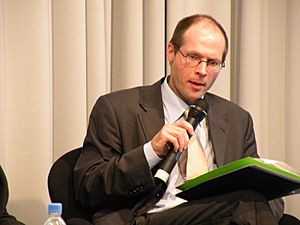
Many people welcome the growth of food banks. They provide a way to help hungry people without needing government money. They also show a growing sense of community and people helping each other. In the UK, for example, many people on both sides of politics have welcomed them.
However, some researchers and politicians are concerned. An American sociology professor, Janet Poppendieck, warned about what happened in the US. She said that once food banks become common, it can be hard for governments to take back the job of feeding hungry people. She also said that running food banks can take so much time that volunteers don't have time to push for bigger changes. But she also noted that food bank workers often have a lot of trust with lawmakers. As of 2012, senior US food bank workers preferred to stay out of politics. Some activists think this might be because of where their funding comes from.
New small food pantries and "Blessing Boxes" have also appeared. These are like "Little Free Libraries" but for food. Some people criticize them. They say these are too small to make a big difference in hunger. They also worry about not having fresh foods and food safety. Some see them as a public relations effort by large food companies.
Rachel Loopstra from University of Toronto said food banks are often not very efficient. She said they can be unreliable and might not provide healthy food. A survey in Toronto found that only 1 in 5 families who struggled with food would go to a food bank. This is partly because people feel ashamed. Elizabeth Dowler, a professor at Warwick University, said most British people prefer the government to help the hungry. Hannah Lambie-Mumford from University of Sheffield agreed that some users feel ashamed. She also said food bank volunteers should be encouraged to push for long-term solutions to poverty and hunger.
Olivier De Schutter, a senior United Nations official, is worried about the rise of food banks. He reminds governments in Europe and Canada that they have a "duty to protect" their citizens from hunger. He suggested that leaving this job to food banks might not be right.
Other critics worry about large food bank networks. They say these networks make hunger seem like a charity problem. This allows governments to ignore growing poverty and hunger. It also lets them ignore their duty to ensure people have the right to food.
See also
 In Spanish: Banco de alimentos para niños
In Spanish: Banco de alimentos para niños


